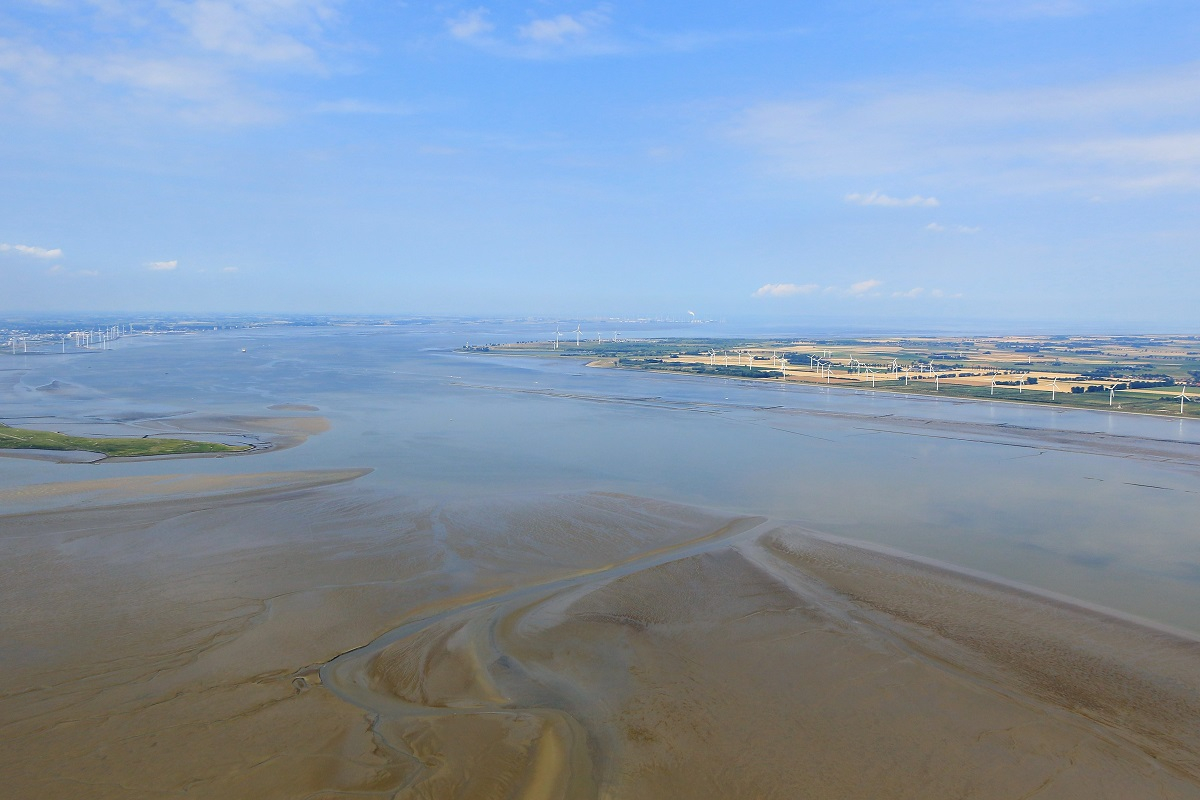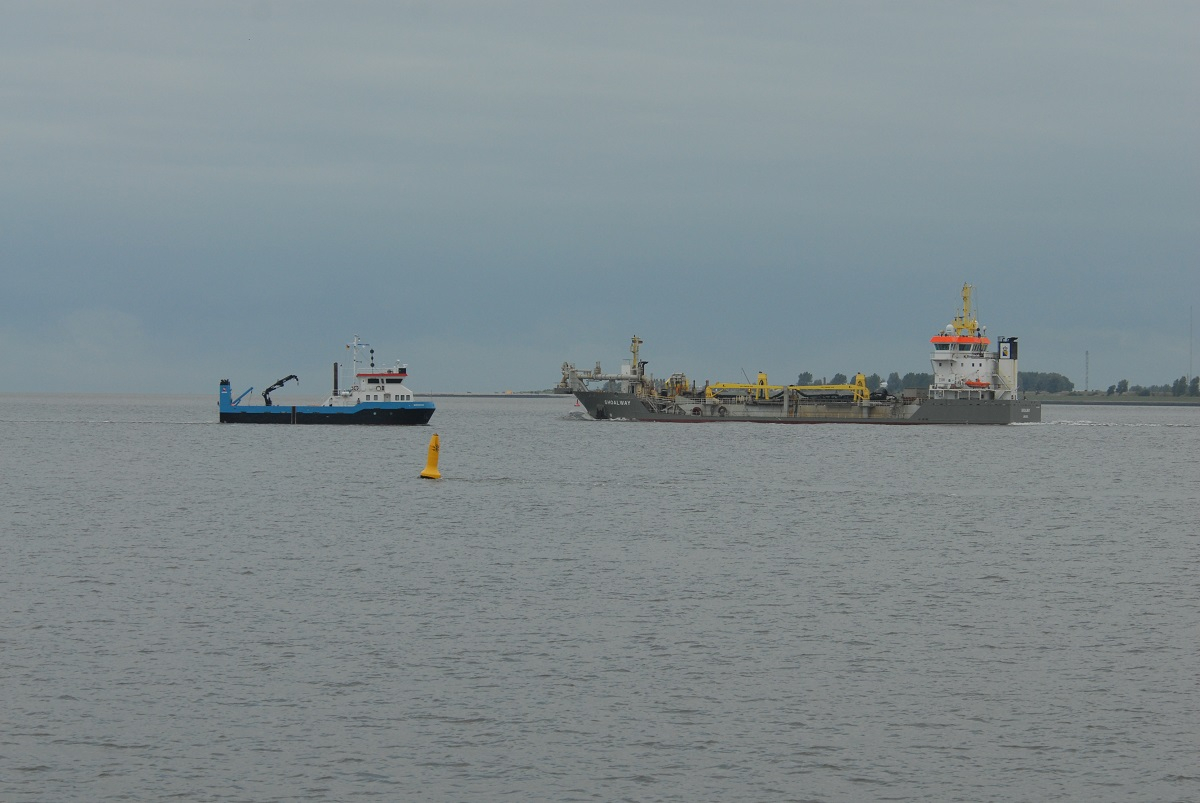Grootschalig onderzoek slib Eems-Dollard | Large-scale study water turbidity Ems-Dollard estuary
Ruimtelijk beeld door 8 schepen tegelijk
In het gebied waar de Eemsrivier uitmondt in de Dollard (het Eems-estuarium) worden op de bodem tien meetframes (zie foto) geplaatst die gedurende drie weken op verschillende dieptes troebelheid, zout en stroomsnelheid meten. Op 28 augustus, gedurende een hele getijcyclus van 13 uur, wordt ook continu vanaf acht schepen gemeten. Dr. Theo Gerkema, NIOZ-onderzoeker: “Bijzonder is dat we met die 8 schepen op verschillende plekken in de Eems gelijktijdig metingen doen, waardoor je gegevens kunt vergelijken en er een ruimtelijk beeld ontstaat van de sedimenthuishouding.” NIOZ-onderzoeksschip RV Navicula verzamelt met twee landers die worden neergelaten aan weerszijden van het schip gegevens over onder andere sedimentconcentraties, korrelgrootte en stroomsnelheid. Op basis van alle verzamelde meetresultaten worden de rekenmodellen verbeterd, zodat de effecten van maatregelen om de troebelheid te verminderen beter kunnen worden voorspeld.
Twee meetrondes
De eerste meetronde wordt uitgevoerd bij verwachte lage afvoer van de Eems-rivier in de periode van 9 augustus tot 7 september 2018. De eerste 13-uursmeting vanaf de schepen vindt plaats op 28 augustus. De tweede meetronde vindt plaats tijdens de verwachte hoge afvoer van de Eems-rivier in januari of februari 2019. Naar verwachting zijn de eerste resultaten in de zomer van 2019 bekend.
Samenwerking
Voor het meetprogramma is samenwerking gezocht met Duitse partijen vanwege de gezamenlijke behoefte aan deze nieuwe kennis voor zowel het Duitse als het Nederlandse waterbeheer. Daarnaast zijn verschillende binnenlandse en buitenlandse universiteiten aangesloten vanwege het unieke feit dat zoveel verschillende aspecten tegelijkertijd gemeten gaan worden.
Onderzoekspartners
Het onderzoek wordt onder regie van Rijkswaterstaat en gecoördineerd door Royal HaskoningDHV, uitgevoerd in samenwerking met de Duitse overheden BAW-DH, NLWKN Norderney en NLWKN Aurich, Bundesanstalt für Gewässerkunde en WSA Emden (Wasserstraßen- und Schifffahrtsamt). Naast NIOZ zijn verschillende Nederlandse, Duitse, Engelse en Amerikaanse onderzoeksinstituten betrokken, zoals Deltares, Universiteit Oldenburg, CAU Kiel, Universiteit Warnemünde, HR Wallingford en University of Maine. Daarnaast zijn specialisten van technische universiteiten van Delft, Twente en Wageningen betrokken voor advies en wetenschappelijke interpretatie.
Programma Eems-Dollard 2050
Het onderzoek maakt onderdeel uit van het Programma Eems-Dollard 2050, een initiatief van de ministeries van Infrastructuur en Waterstaat en van Landbouw, Natuur en Voedselkwaliteit en de provincie Groningen. Hierin werken waterschappen, gemeenten, natuurorganisaties en bedrijfsleven samen aan de verbetering van de ecologie, natuur en waterveiligheid in samenhang met een duurzame economie en leefbaarheid van het Eems-Dollardgebied.
NIOZ part of a large-scale water turbidity study to improve Ems-Dollard ecosystem
A large-scale field study to understand the complex processes in the transition area from the Ems river towards the UNESCO listed Wadden Sea has started on Tuesday 28 August 2018. The results will be used in assessing the effectiveness of measures to reduce water turbidity. The study is part of the Eems-Dollard 2050 program and will investigate how mud behaves in the transition between fresh river water and salty sea water. The research is led by Rijkswaterstaat and coordinated by Royal HaskoningDHV, in collaboration with German authorities and international research institutions, such as NIOZ.
The research project has attracted attention from academics in the United States of America as well as the United Kingdom. The results of the research, as well as recommended interventions, are expected to be shared with other authorities and to contribute to an improved understanding globally of how to keep estuaries and their ecosystems intact and healthy.
Water turbidity as a measure of a healthy ecosystem
Water turbidity is the measure of water clarity; the cloudier the water, the higher the turbidity. The Ems River has large quantities of mud which can cause turbid water, hindering the growth of algae at the bottom of the food chain. This has a knock-on effect on the growth of soil life and fish as their food source is reduced, disrupting the eco-system.
Simultaneous measurements by 8 vessels
At the confluence of the Ems River and the Dollard, ten measuring frames and cables have been placed on the bed of the Ems estuary to measure the turbidity and salt and river flow velocity for three weeks at various depths. During 13-hour-tidal cycles, continuous measurements will be carried out from eight ships at the same time. NIOZ-scientist Dr Theo Gerkema: “measuring simultaneously with 8 vessels in different parts of the estuary, enables us to compare results and render a spatial image of the way in which the sediment behaves”. NIOZ RV Navicula will be deploying two landers with instruments measuring sediment concentrations, particle sizes and water speeds.
Water turbulence is measured as it’s important for the exchange and distribution of mud. The size and fall rate of mud flocs are measured with a special camera and samples of water and soil are taken to measure the sediment concentration. Measurements of all ships will be collated, and calculation models will be created and improved to help find solutions to reduce turbidity.
Two rounds of measurements
During the study two rounds of measurements will take place, one when the river has a high discharge and one when the river has a low discharge to see how the turbidity changes in different situations. The river discharge is the volume of water that passes through the river at any one point of time.
The first round of measurements will be carried out when there is predicted low discharge in the Ems River from 9 August to 7 September 2018, during which the first 13-hour measurement with the ships will take place on August 28th. The second round of measurements will take place when there is predicted high river discharge of the Ems river in January/February 2019. Following this, the first set of results are expected to be announced in the summer of 2019.

